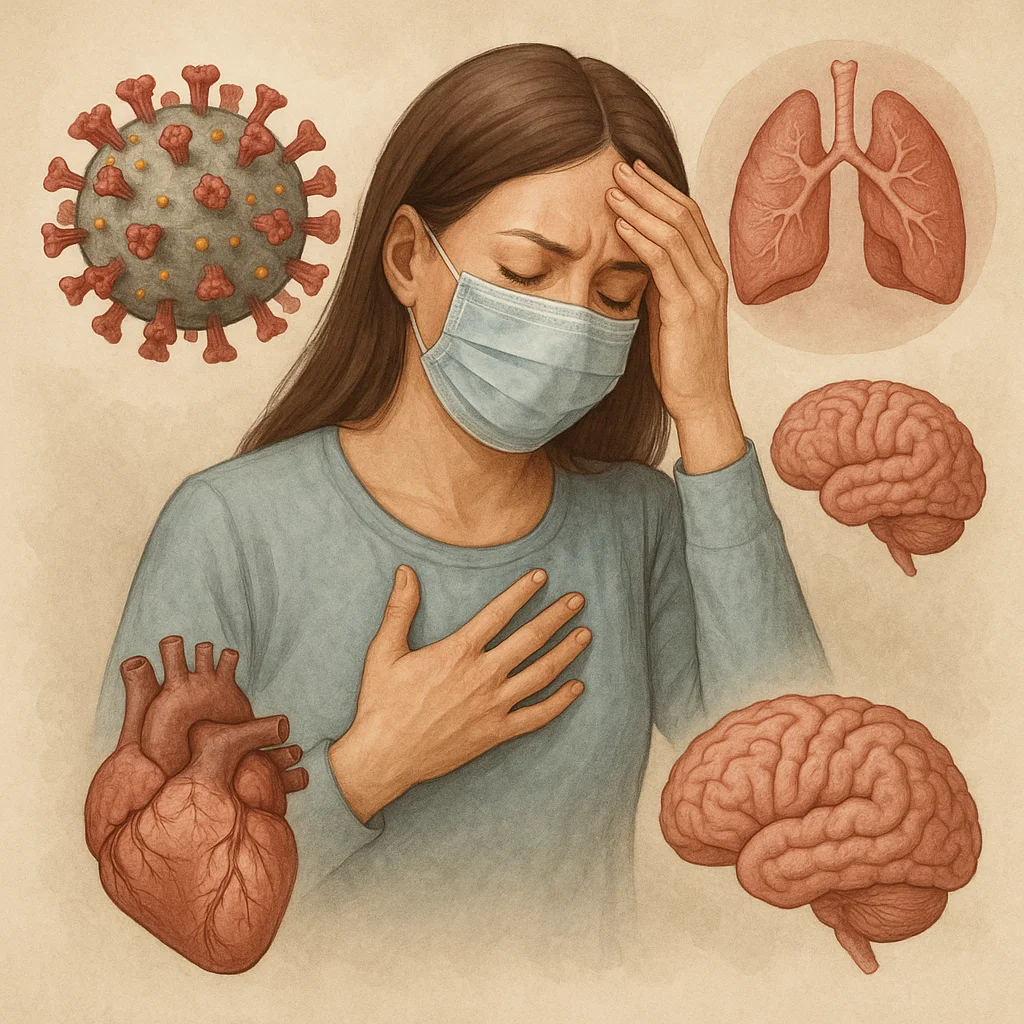Global prevalence and public‑health impact
Estimates suggest that roughly 6–7 percent of adults who have had the infection go on to develop lasting symptoms beyond three months of recovery. Although rates differ by region, age group, and study methodology, a worldwide conservative estimate places the number of affected individuals in the tens of millions. Early in the pandemic, as many as one in ten survivors reported prolonged effects; more recent data indicate some decline in incidence, likely reflecting the protective impact of vaccination and evolving variants World Health Organization. However, the condition remains a significant public‑health concern, contributing to substantial productivity losses and straining rehabilitation and support services.
Common symptoms and patterns
People living with post‑COVID syndrome often experience:
Fatigue and post‑exertional malaise, where even minor physical or mental activity leads to marked symptom worsening
Breathlessness or chest discomfort, despite normal imaging or lung function tests
Cognitive difficulties (“brain fog”), affecting memory, concentration, and processing speed
Muscle or joint pains, headaches, and disrupted sleep
Autonomic disturbances, such as rapid heart rate upon standing or temperature dysregulation
These symptoms can fluctuate in intensity and may overlap with other chronic conditions, such as myalgic encephalomyelitis/chronic fatigue syndrome, making diagnosis challenging Wikipedia.
Underlying mechanisms: piecing together the puzzle
Researchers agree there is no single explanation; rather, multiple interrelated processes likely play roles:
Immune dysregulation and inflammation: Persistent activation of the immune system may result from lingering viral particles or reactivation of dormant viruses, leading to chronic inflammation and tissue damage
Microvascular and clotting abnormalities: Tiny blood‑vessel dysfunction and microclots can impair oxygen and nutrient delivery to tissues, contributing to fatigue and cognitive issues.
Autonomic nervous system imbalance: Disruption of signals between the brainstem and heart or gut may underlie orthostatic intolerance and heart‑rate variability problems.
Metabolic and mitochondrial dysfunction: Changes in cellular energy production pathways, including reduced levels of crucial metabolites, have been observed in preliminary studies
Organ‑specific sequelae: Damage to lungs, heart, kidneys, or brain from the acute phase may cause long‑term impairment, even when initial infection was mild.
Despite promising leads, consistent biomarkers remain elusive, and none of these hypotheses fully accounts for the syndrome’s heterogeneity.
Who is at higher risk?
Several factors raise the likelihood of developing post‑COVID syndrome:
Severity of initial illness: Hospitalization and intensive care carry greater risk, though many non‑hospitalized individuals also struggle with prolonged symptoms
Female sex and older age: Women and older adults appear more susceptible, though reasons aren’t fully clear.
Underlying health conditions: Pre‑existing respiratory issues, obesity, and smoking history may predispose to lasting effects.
Repeated infections: Emerging evidence suggests multiple infections compound risk.
However, cases among young, otherwise healthy people emphasize that this syndrome can affect anyone.

Challenges in recognition and care
Because there is no definitive laboratory test, diagnosis rests on clinical history and exclusion of other causes. Treatment focuses on symptom relief and rehabilitation:
Pacing and graded activity for those with severe fatigue
Breathing exercises and physical therapy to improve lung capacity and mobility
Cognitive rehabilitation to address brain‑fog symptoms
Specialized clinics offering multidisciplinary support
Access to these services varies widely, and many patients report difficulty obtaining validation and longitudinal care.
Research frontiers and hope for tomorrow
Ongoing trials are exploring antivirals, immune modulators, and metabolic therapies. Artificial‑intelligence platforms have begun identifying subtle biomarker patterns from routine blood and stool tests, guiding more personalized approaches. International collaborations seek to standardize case definitions and outcome measures, paving the way for large‑scale studies capable of revealing effective interventions.
What we still don’t know
Key uncertainties include:
Why some individuals recover while others don’t
The precise interplay among immune, vascular, and neurological factors
Long‑term trajectory beyond two years—will some people face lifelong impairment?
Optimal therapies—no universally effective treatments exist yet.
Closing these gaps will require sustained funding, patient involvement, and data sharing across borders.
As you navigate life with post‑COVID syndrome, we understand how daunting an uncertain prognosis can feel. Cryopreservation is not a cure; rather, it offers an opportunity, a way to preserve hope for when future advances may unlock more effective treatments. If you’re interested in learning how cryopreservation works or exploring whether it might be right for you, we’re here to explain every step.
About Tomorrow.bio
At Tomorrow.bio we are dedicated to advancing the science of cryopreservation with the goal of giving people a second chance at life As Europe’s leading human cryopreservation provider we focus on rapid high-quality standby, stabilization and storage of terminal patients preserving them until future technologies may allow revival and treatment.
Our mission is to make human cryopreservation a reliable and accessible option for everyone We believe that no life should end because current capabilities fall short.
Our vision is a future where death is optional where people have the freedom to choose long-term preservation in the face of terminal illness or fatal injury and to awaken when science has caught upInterested in learning more or becoming a member
📧 Contact us at hello@tomorrow.bio
🌐 Visit our website www.tomorrow.bio
🤝 Schedule a call with our team Book a consultation



